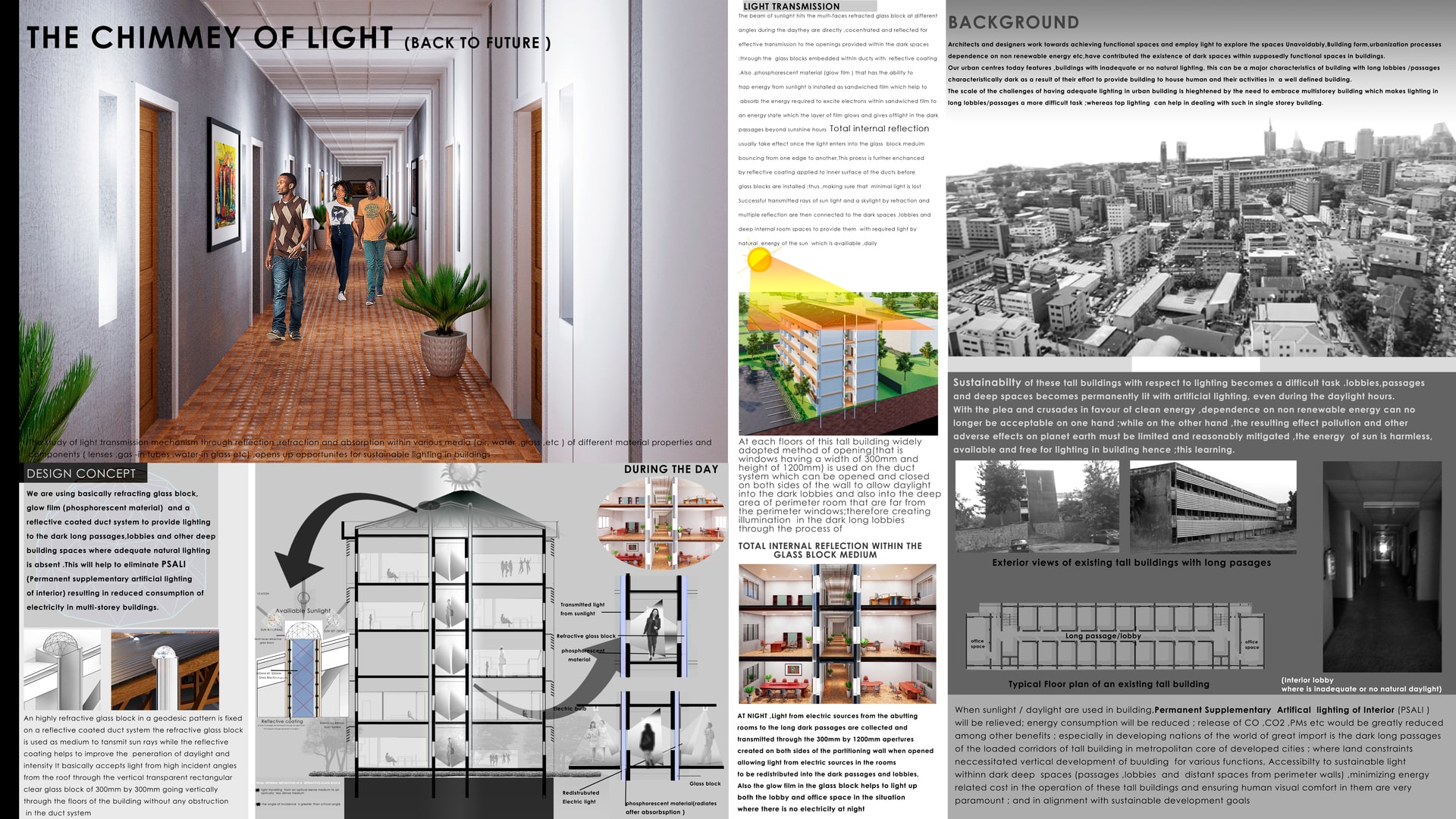Project Description
THE CHIMMEY OF LIGHT (BACK TO THE FUTURE) BACKGROUND Architects and designers work towards achieving functional spaces and employing light to explore the spaces.Unavoidably,Building form and urbanization processes dependences on non-renewable energy. The existence of dark spaces within supposedly functional spaces in the building. Our urban centers today feature buildings with inadequate or no natural lighting, and this can be a major characteristic of building with long lobbies /passages characteristically dark as a result of their effort to provide a place to house human and their activities in a well-defined building. The scale of having adequate lighting in urban building is heightened by the need to embrace multi-storey buildings, which makes lighting in long lobbies /passages a more difficult task, whereas top lighting can help in dealing with such in simple storey building. Sustainability of these tall buildings with respect to lighting becomes a difficult task, lobbies and passages with deep spaces becomes permanently lit with artificial lighting even in daytime. With the plea and crusades in favour of clean energy, dependence on non-renewable energy can no longer be acceptable on one hand, on the other hand, the resulting pollution and effects on earth must be limited and reasonably mitigated. When sunlight / daylight is used in buildings, (PSALI) will be relieved; energy consumption will be reduced; release of CO, CO2, PMs, etc. would be greatly reduced among other benefits; especially in developing nations of the world. Of great importance is the dark long passages of the double loaded corridors of tall buildings in metropolitan core of developed cities; where land constraints necessitated vertical development of buildings for various functions. Accessibility to sustainable light within dark deep spaces (passages,and distant spaces from perimeter walls), minimizing energy related cost in the operation of these tall buildings and ensuring visual comfort in them are very paramount; and in alignment with sustainable development goals. The study of light transmission mechanism through reflection, refraction and absorption within various media (air, water, glass, etc.)of different material properties and components, opens up opportunities for sustainable lighting in buildings. LIGHT TRANSMISSION The beam of sunlight hits the multi-faces refractive glass block at different angles during the day. They are directed, concentrated and reflected for effective transmission to the openings provided within the dark spaces; through glass blocks embedded within ducts with reflective coating. Also, phosphorescent material (glow film) that has the ability to trap energy from light is installed as sandwiched film which help to absorb the energy required to excite electrons within sandwiched film to energy state at which the layer of film glows and gives off light in the dark passages beyond sunshine hours. Total internal reflection usually take effect once the light enters into the glass block medium; bouncing from one edge to another. This process is further enhanced by the reflective coating applied to the inner surface of the ducts before glass blocks are installed; thus, making sure that minimal light is lost. DESIGN CONCEPT Basically, we are using refracting glass block, glow film ( phosphorescent material), and a reflective coated duct system to provide lighting to the dark long passages, lobbies, and other deep building spaces where adequate natural lighting is absent.This will help to eliminate PSALI (Permanent Supplementary Artificial Lighting of Interiors), resulting in reduced consumption of electricity in multi-storey buildings. A highly refractive glass block in a geodesic pattern is fixed on a reflective coated duct system. The refractive glass block is used as a medium to transmit sun rays while the reflective coating helps to improve the penetration of daylight and intensity. It basically accepts light from high incident angles from the roof through a vertical transparent rectangular clear glass block of size 300mm by 300mm going vertically through the floors of the building without obstructions in the duct system. At each floors of tall buildings, a widely adopted method of opening (i.e., Windows of width 300mm and height of 1200mm) is used on the duct system which can be opened and closed on both sides of the wall to allow daylight into the dark lobbies and also into the deep areas of perimeter room that are far from the perimeter windows; therefore, creating illumination in the dark long lobbies through the process of Total Internal Reflection within the glass block medium. At night, light from electric sources from the abutting rooms to the long dark passages are collected and transmitted through the 300mm x1200mm apertures created on both sides of the partitioning wall when opened allowing light from electric sources in the rooms to be redistributed into the dark passages and lobbies. Also the glow film in the glass block helps to light up both the lobby and offices spaces in the situation where there is no electricity at night
